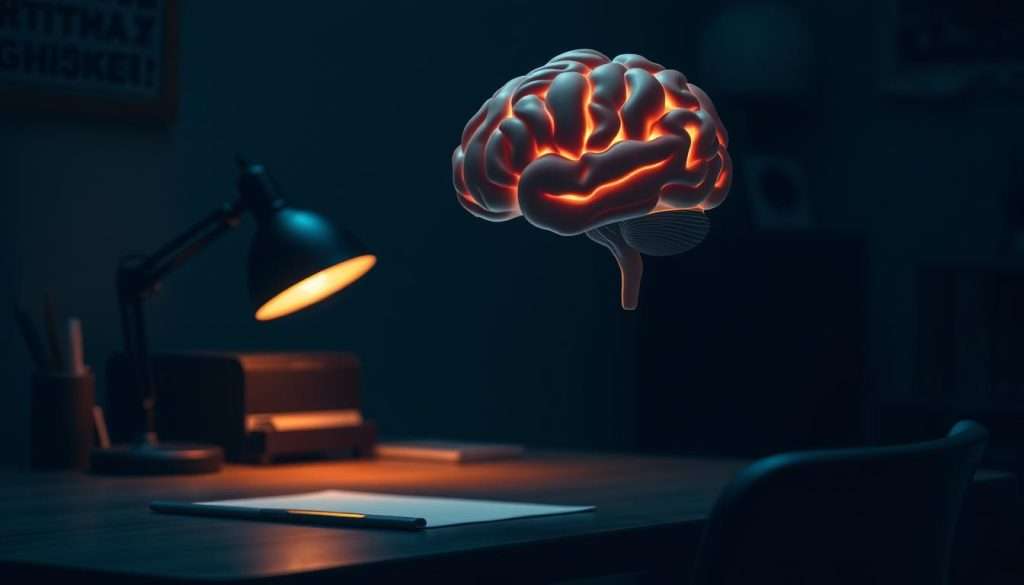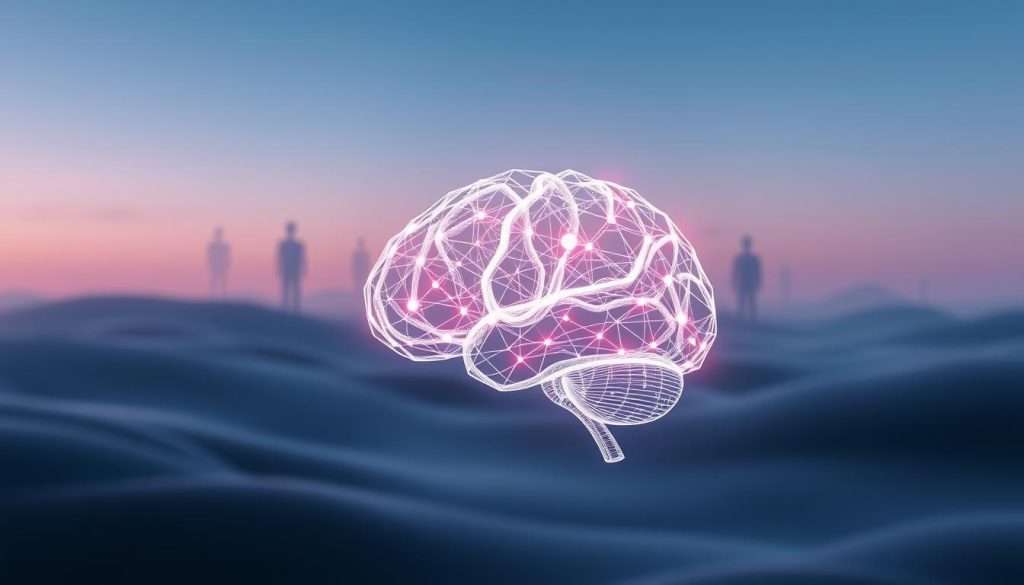Ever felt stuck, unable to reach your goals? We often let fears, old beliefs, and untested assumptions hold us back. It’s time to debug your mind and unlock your full potential!
Imagine having the mental clarity to focus on what truly matters. And the confidence to take bold steps towards success. By optimizing your mindset, you can overcome mental barriers and achieve personal growth. This isn’t just about positive thinking; it’s about cognitive optimization. A systematic approach to identifying and rewriting the mental patterns that slow you down.
We’re here to guide you through this transformative process. By the end of this article, you’ll know how to debug your mind for success. And start making progress towards your goals.
Key Takeaways
- Understand the concept of debugging your mind for personal growth.
- Learn how mental clarity can improve your focus and confidence.
- Discover the importance of cognitive optimization in achieving success.
- Identify the hidden fears and outdated beliefs that hold you back.
- Start your journey towards a growth-oriented mindset.
Understanding Mental Debugging
Debugging your mind is a way to clear your thoughts and live a better life. It’s about finding and fixing the mental “bugs” that slow us down.
What It Means to Debug Your Mind
Debugging your mind means knowing your thoughts, feelings, and actions. Then, you work on making them better. It’s a journey of self-discovery and growth that helps you reach your goals.
The Science Behind Mental Optimization
The science of mental optimization is about how our brain works. By using self-awareness techniques and mindset enhancement, we can change our brain’s thinking. This makes us think more positively and productively.
Signs Your Mind Needs Debugging
How do you know if your mind needs fixing? Look out for negative thoughts, self-doubt, and feeling stuck. Recognizing these signs and acting on them can start your mental debugging journey.
The Mental Operating System: How Your Mind Works
It’s key to understand how our mind works to improve our mental performance. Our mental system is a mix of different processes. These processes affect how we think, feel, and act.
Conscious vs. Subconscious Processing
Our mind has two main parts: conscious and subconscious. The conscious mind is where we’re aware of our thoughts and surroundings. On the other hand, the subconscious mind works quietly, guiding our actions and decisions without us knowing.
Thought Patterns and Neural Pathways
Thought patterns are the paths our brain takes when processing info. When we think the same thoughts over and over, it creates neural pathways. This makes it simpler to follow these patterns later. Knowing this can help us optimize our cognitive performance by changing these pathways.
The Role of Beliefs in Mental Programming
Our beliefs are very important in shaping our mental programming. They affect what we see as possible or not. This directly impacts our mental health strategies and overall well-being.
Common “Bugs” in Your Mental Software
Ever feel like your brain is running on outdated software? You’re not alone! Our minds are complex systems that can develop glitches. These glitches affect our thoughts, feelings, and actions. Let’s explore some common “bugs” that can hinder our progress.
Cognitive Biases That Limit Success
Cognitive biases are like pre-installed apps that we never bothered to update. They distort our perception of reality, leading to poor decisions. Two significant biases that can limit our success are:
Confirmation Bias
This bias makes us favor information that confirms our existing beliefs. For instance, if you believe you’re not good at public speaking, you’ll likely focus on instances where you messed up. This reinforces that belief.
Negativity Bias
Our brains are wired to respond more strongly to negative experiences than positive ones. This can lead to a skewed view of reality. We overemphasize the negative aspects of our lives.
Negative Thought Loops and How They Form
Negative thought loops are like being stuck in a never-ending loop of a bad song. They form when we repeatedly dwell on negative thoughts. For example, worrying about a job interview can lead to a loop of negative self-talk. This makes you even more anxious.
Self-Limiting Beliefs and Their Origins
Self-limiting beliefs are like invisible barriers that hold us back. They often originate from past experiences or messages we received from others. For instance, a child who was told they’re not good at math might grow up believing they’re not capable of learning it.
| Mental Bug | Description | Impact |
|---|---|---|
| Confirmation Bias | Favoring information that confirms existing beliefs | Reinforces negative self-perception |
| Negativity Bias | Responding more strongly to negative experiences | Skews view of reality, emphasizing negative aspects |
| Negative Thought Loops | Repetitive dwelling on negative thoughts | Creates mental rut, increases anxiety |
Recognizing these mental “bugs” is the first step towards debugging our minds. By understanding how they work and impact our lives, we can start to overcome them. This will help us achieve greater mental clarity.
Preparing to Debug Your Mind: Creating the Right Environment
Starting to debug your mind means setting up the right space. This means making your physical area clear and cutting down on digital distractions.
Physical Space Optimization
Your surroundings greatly affect your mind. Begin by cleaning up your space. A tidy area can lower stress and boost focus.
Organize your work and living areas. This helps create a calm and clear atmosphere.

Digital Detox Strategies
Today, it’s hard to avoid the constant digital noise. Digital detox helps clear your mind. Try not using devices for certain times or days.
Setting the Stage for Mental Clarity
To fix your mind, you need a clear mental space. Use self-awareness techniques and mental health strategies that fit you. This helps you spot and fix mental issues.
By improving your environment and reducing digital noise, you’re on the path to a clearer mind.
Diagnostic Tools: Self-Awareness Techniques
As we work on debugging our minds, it’s key to learn self-awareness techniques. Self-awareness lets us watch ourselves, our thoughts, and feelings without judging. This skill helps us spot areas to improve and fine-tune our mental systems.
Mindfulness Practices for Mental Clarity
Mindfulness is a great way to boost self-awareness. It helps us stay in the present, watching our thoughts and feelings without getting lost in them. Regular mindfulness practice sharpens our mental clarity and focus.
Journaling Methods to Identify Thought Patterns
Journaling is a strong tool for self-awareness. Writing down our thoughts and feelings helps us spot patterns and understand our minds better.
Thought Records
Keeping thought records is a useful journaling method. It involves writing down our thoughts, emotions, and what triggers them. By looking at these records, we can spot and challenge negative thought patterns.
Pattern Recognition Exercises
Pattern recognition exercises help us find common themes in our thoughts and feelings. This understanding lets us see our mental habits and where we can improve.
| Journaling Method | Description | Benefits |
|---|---|---|
| Thought Records | Recording thoughts, emotions, and triggering situations | Identifies negative thought patterns, challenges distorted thinking |
| Pattern Recognition Exercises | Identifying common themes and patterns in thoughts and emotions | Understand mental habits, identifies areas for improvement |
Feedback Loops: Using External Input
While looking inward is important, outside feedback is also valuable. Talking to trusted friends, family, or mentors can reveal blind spots and offer new views on our thought patterns.
Debug Your Mind: The Step-by-Step Process
To improve your mental performance, you need to debug your mind. This means identifying and challenging negative thoughts. It’s a process that helps you overcome mental blocks and boost your well-being.
Identifying Problematic Thought Patterns
The first step is to notice your thoughts. Look out for negative self-talk and other thought distortions. Being aware of your thoughts helps you spot areas for improvement.

Isolating Mental Bugs Through Reflection
Reflection is key to finding mental bugs. Journaling or meditating can give you insight into your thoughts. It helps you see recurring negative patterns.
Techniques for Cognitive Restructuring
Cognitive restructuring changes negative thoughts into positive ones. You can use techniques like reframing and positive affirmations.
Reframing Negative Thoughts
Reframing means swapping negative thoughts for more balanced ones. For example, “I’ll never be able to do this” becomes “I’ll learn and grow from this experience.”
Creating Positive Affirmations
Positive affirmations are powerful statements. Repeating them, like “I am capable and confident,” boosts your self-esteem and mindset.
Implementing New Mental Subroutines
After challenging negative thoughts, it’s time to adopt new ones. Practice new habits and thoughts until they become second nature.
| Technique | Description | Benefits |
|---|---|---|
| Reframing Negative Thoughts | Replacing negative thoughts with balanced ones | Reduces stress and anxiety |
| Positive Affirmations | Repeating positive statements to rewire the brain | Boosts self-esteem and confidence |
| Mindfulness Meditation | Practicing mindfulness to become more aware of thoughts | Enhances mental clarity and focus |
By following these steps and using mindset enhancement techniques, you can debug your mind. This leads to a more balanced and productive life. Remember, psychological optimization is an ongoing journey that needs patience and persistence.
Advanced Debugging Techniques
We’ve started learning how to debug our minds. Now, let’s explore more advanced methods for cognitive optimization. These techniques help us improve our mental clarity and well-being.
Cognitive Behavioral Approaches
Cognitive Behavioral Therapy (CBT) is a key tool for mental health strategies. It helps us change negative thought patterns to positive ones. This can help us overcome biases and beliefs that hold us back.
Neuroplasticity Exercises
Neuroplasticity exercises help our brains adapt and change. They can be as simple as trying a new hobby or as complex as learning a new language. These exercises build cognitive reserve and help us adapt to new situations.
Brain Training Activities
Brain training activities, like puzzles and brain teasers, challenge our brains. They improve cognitive function and are fun ways to build cognitive reserve.
Habit Formation Strategies
Creating new habits can recalibrate our mindset. Positive habits in our daily routine support our mental health. Techniques like habit stacking and implementation intentions help us maintain new habits.
Meditation Practices for Mental Optimization
Meditation is a powerful tool for mental optimization. It reduces stress, improves focus, and boosts well-being. Regular meditation makes us calmer and better equipped to face life’s challenges.
By using these advanced debugging techniques daily, we can reach a deeper level of cognitive optimization. This improves our mental health significantly.
Optimizing Your Mental Performance
Now that we’ve debugged our minds, it’s time to optimize our mental performance. This means taking care of our brain health through good nutrition, sleep, and exercise. By focusing on these key areas, we can boost our brain power and stay sharp.
Brain Health and Nutrition
A well-nourished brain is key for top mental performance. Foods rich in omega-3 fatty acids, antioxidants, and vitamins are vital for brain health. Eating foods like salmon, nuts, and leafy greens can help. Also, drinking plenty of water is important for staying focused and clear-minded.
Sleep Optimization for Cognitive Function
Sleep is crucial for mental performance. Our brain processes and consolidates information while we sleep. Getting a consistent sleep schedule and creating a sleep-friendly environment can greatly improve sleep quality. Aim for 7-9 hours of sleep each night to keep your brain sharp.
Physical Exercise and Mental Clarity
Regular exercise is great for both body and brain. It improves cognitive function, boosts mood, and enhances mental clarity. Doing aerobic exercises like running or cycling increases blood flow to the brain, supporting brain health. Even a short walk can help improve mental performance.
By combining good nutrition, sleep, and exercise, we can greatly improve our mental performance. These strategies support brain health, enhance cognitive function, and keep our minds clear.
Maintaining Your Debugged Mind
Keeping your mind in top shape is a continuous effort. It’s like keeping a computer updated and virus-free. Your mind needs regular care to stay sharp.
Daily Practices for Mental Hygiene
To keep your mind clear, start daily habits that boost mental health. This includes:
- Meditation and mindfulness exercises
- Journaling to track thoughts and emotions
- Gratitude practices to foster a positive mindset
Marcus Aurelius once said, “The impediment to action advances action. What stands in the way becomes the way.” These habits help turn challenges into chances for growth.
Handling New Mental Bugs as They Arise
New mental issues can pop up, even with a sharp mind. The important thing is to deal with them quickly. Use self-awareness techniques to spot and fix negative thoughts or beliefs.
| Mental Bug | Self-Awareness Technique | Action Plan |
|---|---|---|
| Negative self-talk | Mindfulness meditation | Replace negative self-talk with affirmations |
| Procrastination | Journaling | Break tasks into smaller, manageable steps |
Creating Sustainable Mental Habits
To improve your mindset for the long haul, focus on building lasting mental habits. Set achievable goals, track your progress, and celebrate small wins.
By sticking to these tips and keeping up with your mental care routine, you can enjoy lasting mental clarity. You’ll continue to grow and get better over time.
Conclusion: Your Continuously Improving Mental Operating System
Debugging your mind is a continuous effort that needs dedication and practice. You’ve learned that optimizing your mindset means understanding your mental system. It’s about fixing “bugs” and keeping your mindset sharp for top performance.
Using the methods and strategies shared, you’re on the path to better mental health. This journey is about living a life of constant growth. Every step towards fixing your mind brings you closer to reaching your full potential.
Your mind is always changing, and with care, it can work better. We suggest making mental adjustments a regular habit. This way, you’ll always be ready to face challenges and reach your goals.

